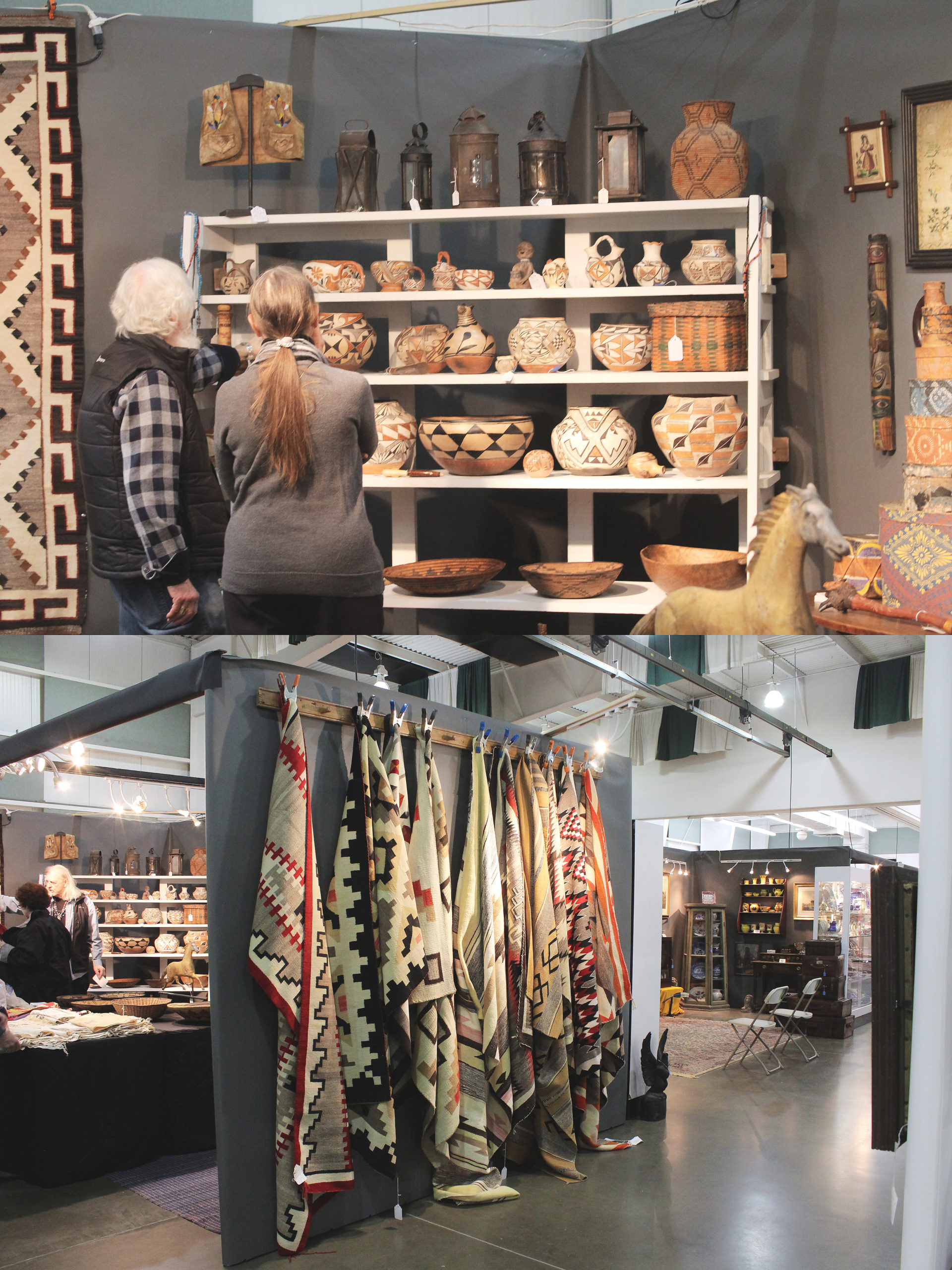
Steve Smoot, Lancaster, Penn., had “a wonderful show with a lot of sales.” Navajo blankets decorated the outside of his booth, and a display of Acoma, Zuni and Hopi pottery kept Smoot busy with customers.
Review and Photos by Z.G. Burnett
YORK, PENN. – The Original Semi-Annual York, Penn., Antiques Show and Sale celebrated its 180th event on February 3 and 4. Its dealers and buyers were undaunted by the punishing winds and some of the coldest temperatures felt on the East Coast this season. Inside the York Fairgrounds and Convention Center, 65 exhibitors created microworlds within their booths, decorating them with their best inventory. Dealers reported great sales on both days, with the majority of buyers purchasing on Saturday, but traffic was steady all weekend. “There were customers who came for both days,” said Melvin “Bud” Arion, who manages the show. “And new people visited on both days!” In addition to the next generation of dealers either taking up the family business or representing themselves, exhibitors noticed an increase in much younger adult buyers actively attending, if not buying, at the show. The first step is getting them in the door, and this renewed interest is a relief to many of those with concerns about the future of antiques.
Every category of Americana was represented at the show, displaying a wide range of styles and dating from the Seventeenth Century up to Midcentury Modern. Children’s furniture was frequently spotted, as were antique brooms, which some dealers credited to outside influence. “Martha Stewart shows an antique watering can on the cover of her magazine,” said one dealer who preferred to remain anonymous, as an example. “And suddenly we can’t keep any in stock! I’m not complaining, it’s just funny.” Trends aside, one never knows what might appear in any of the York show’s booths.
The centerpiece of Bob Hanebergs’ display was a child’s desk, likely second half of the Eighteenth Century, that was just as accommodating and function as an adult’s desk despite its diminutive size. Its slant top rested on two retractable runners to reveal three drawers and six pigeon-holes, and one wonders what type of stationery and correspondences a child of this size might have stored within. The desk retained its original hinges and had replaced brasses, but these were older and did not distract from the overall appearance. The Hanebergs, East Lyme, Conn., were asking $2,300.
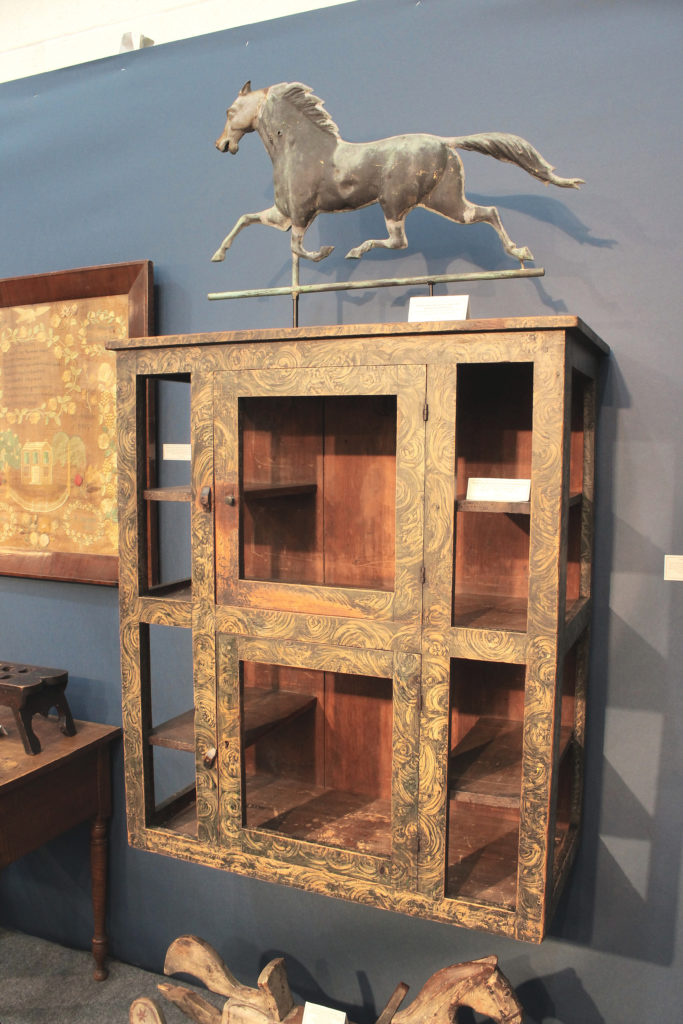
Choosing from the fabulous stock of Stephen F. Still, Manheim, Penn., was a task, but this New England pine pie safe from the first half of the Nineteenth Century was too good to miss at $3,500; the Nineteenth Century molded copper “Ethan Allen” running horse weathervane was $1,750.
Marvin Wies Folk Art, Baltimore, Md., swept up the broom market, showing examples of all ages and sizes in his booth, where Wies and his wife Leslie were hosting. “People are just crazy over brooms!” he exclaimed. This was Wies’ fifth time exhibiting at the York show, and was already in good spirits with the first morning’s turnout. In addition to brooms, Wies offered quite a few children’s toys, including cloth balls in a wire basket, miniature furniture and a flock of wood and felt sheep on a Nineteenth Century painted green lap desk. The sheep were priced from $40 to $85, and he was asking $795 for the lap desk.
Sandy Jacobs, Swampscott, Mass., brought a similarly grassy motif, although much more striking upon closer inspection. Hanging in her booth was a wonderfully carved sheaf of wheat, bundled in a well-rendered length of rope. The sheaf was carved on the top and bottom to resemble the natural form of the stalks, and the knotted rope gave the piece an almost trompe l’oeil effect. Although this distinctive piece of folk art surprisingly did not sell, Jacobs shared later, “I had a great show! Sold across the board.” She was pleased with the two-day show and added that this format worked very well for traffic and customers.
Frank Gaglio, Rhinebeck, N.Y., showrunner of Barn Star Antiques, brought another unusual wall carving: a signed beluga whale by Wick Ahrens (b 1944). Known for his sculptures of whales and other sea mammals, Ahrens is currently active in Vermont and California. He began studying art at age 8 and studied at the Vesper George School of Art, San Francisco, and in the studio of Clark Vorhees, Weston, Vt. Ahrens worked in cabinetry while honing his craft of marine mammal carving, later studying actual gray whales in the Baja Peninsula, Mexico, once being allowed to stroke the throat of a 40-foot subject. Soon after in 1985, Ahrens sculpted an 18-foot whale, the world’s largest wooden cetacean, for the Coyote Point Museum which is now the CuriOdyssey Science Playground & Zoo in San Mateo, Calif.
Another rare animal sighting was a cobalt stoneware cat in the booth of Christopher and Bernadette Evans Antiques, Waynesboro, Va. The pair grew up in the antiques business, and Chris shared that they have been at York for 14 or 15 years. Appearing almost glasslike from afar, the seated cat was made of molded stoneware with hard incised details and covered with a dark cobalt glaze. It was likely created in the first quarter of the Twentieth Century in Zanesville, Ohio. The cat had some restoration to its ears, but the overall effect made this easy to overlook; it was priced $1,850.
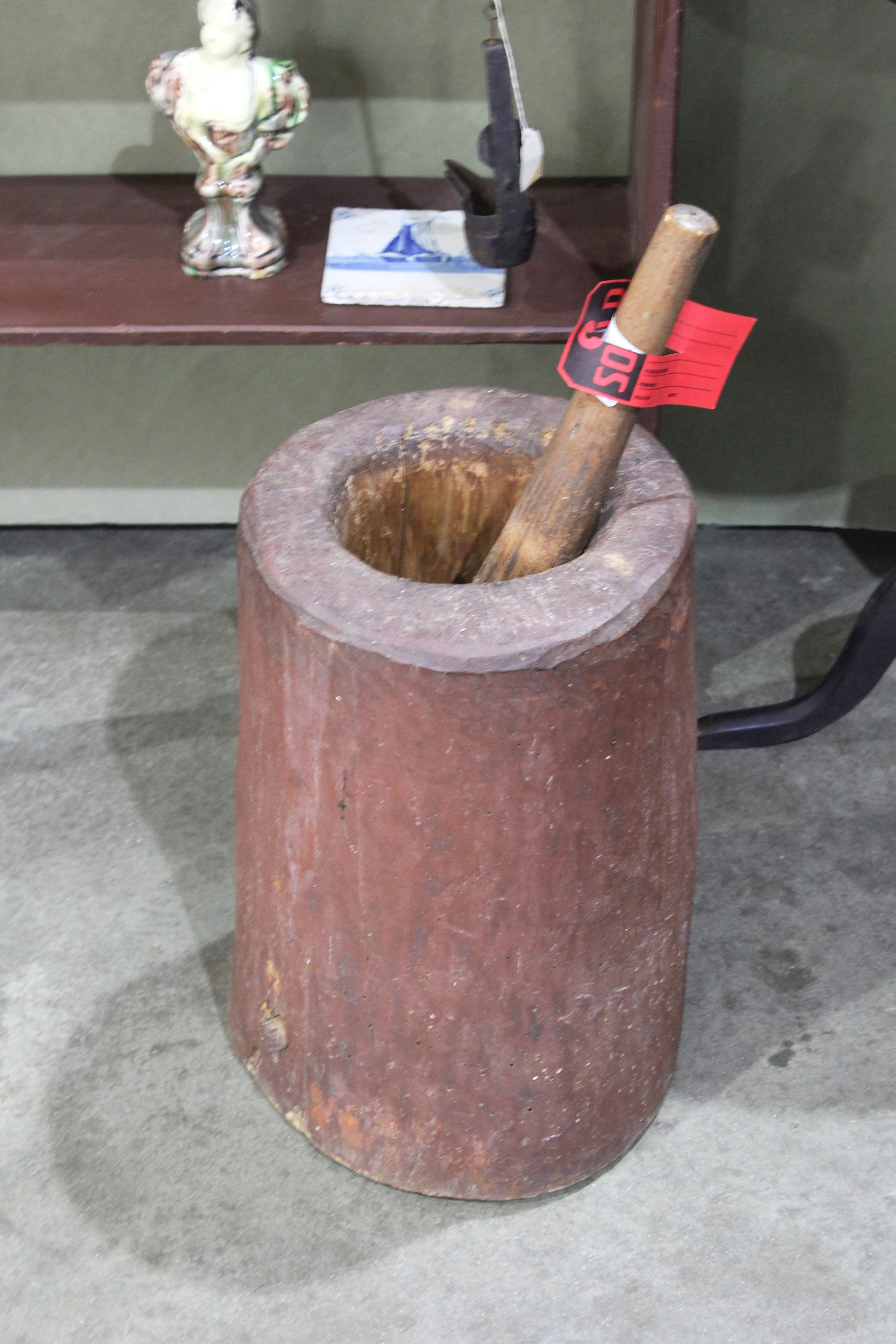
One of the many “sold” signs that sprouted in the first few hours of Friday’s show was on this early mortar and pestle from Hollis E. Brodrick, Portsmouth, N.H.
A more whimsical example of representational art was found in the booth of Firehouse Antiques, Galena, Md. Perched on a display pole was half of a life-sized monochromatic, papier mache pig. Just in time for Mardi Gras, the pig was a Twentieth Century parade costume, complete with a weighted tail on its rear end. The pig attracted much attention from all who came across it, and was reasonably priced at $750.
There was no shortage of amusement among the booths, and some of the dealers even decided to get a bit cheeky with their stock. At the bottom of a traditional frakturs display in the space shared by Philip Bradley Antiques and Lisa Minardi was a hand-painted drawing of an unfortunate fellow who lost his footing, rendered by 13-year-old Theodore S. Geiger, of Manchester, Md., in 1846 that was priced at $1,200. The Norwoods’ Spirit of America, Timonium, Md., displayed an even sillier early sketch of a very flexible man decorating a notation for $950. And Hollis E. Broderick, Portsmouth, N.H., who was sharing a space with Randi Ona, Wayne, N.J., brought a 1761 satirical print by William Hogarth at $495.
The fun and games continued with Ziebarth’s Antiques, Avoca, Wis., with an early Twentieth Century pedal car in original paint. “I just got it!” said Zach Ziebarth, whose energy at the beginning of the first day was infectious. The car showed all original paint and was the best example of its type that Ziebarth had yet come across. Another vibrant artifact from pastimes was a “lavish” red-painted games wheel offered by Michael Paul Gunselman Antiques, Centreville, Del. Asking $550, the wheel was from about the 1930s and found in Salem, N.J. Gunselman was accompanied by his canine associate, Mishka, who was more interested in soliciting belly rubs than sales.
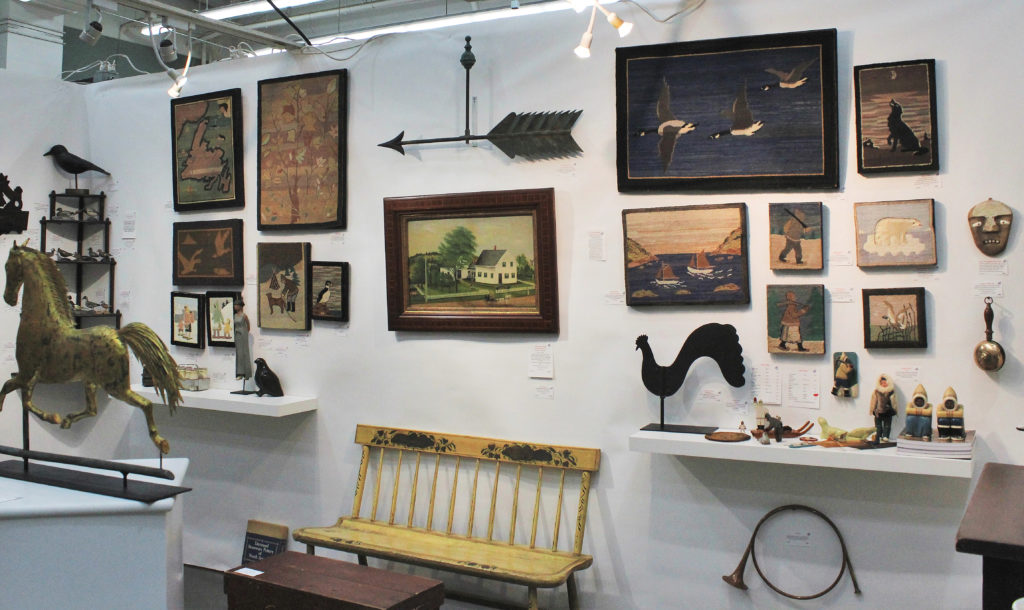
Ron and Joyce Bassin of Bird in Hand Antiques, Florham Park, N.J., had a great Grenfell rug selection of which they “sold a few.”
Less responsive was the circa 1865 cast iron and lead whippet with old paint that guarded the shared booth of Wesley T. Sessa, Pottstown, Penn., and Donald Heller of Heller Washam Antiques, Portland, Maine. The dealers’ stock was so cohesive that it was only possible to distinguish between their pieces by the descriptive price tags. Sessa cornered the left front edge of their booth, displaying a pair of Philadelphia side chairs with pierced Gothic splats, carved crests and molded stiles, both with their original slip seats and untouched surfaces, for $4,900. Between these was a small, rare mahogany chest of drawers, probably from Virginia or coastal North Carolina. Made in the last quarter of the Eighteenth Century, the chest was in as-found condition with its original hardware and feet, and priced at $5,200.
Another eye-catching piece in the booth from Heller was a late Eighteenth or early Nineteenth Century tavern sign, reading “S. York/1830” with a girl in a faded red dress riding a white horse. Signs like these are difficult to date with certainty as they were often stripped, painted over, or both. This design seemed to be the base layer, and the sign depicted a gentleman in profile on the rear surface. “I’m hoping it’s from Pennsylvania,” Heller confided. “But it might be from New England.” His reasoning for this was the sign’s hangers, “New England iron forging tended to be heavier and cruder, while Pennsylvania and especially Philadelphia shows finer blacksmithing [from the period].” Either way, it was one of the show’s best tavern signs and was offered for $3,900.
Hooked rugs were abundantly displayed on dealers’ walls, but the largest collection of Grenfell rugs was presented by Bird in Hand Antiques, Florham Park, N.J. “We sold a few,” said Ron Bassin. “We also sold some decoys; those have been doing well the last three shows especially.” While some exhibitors are most concerned with offloading large or high-ticket items, Bassin explained, “I primarily come to this show to buy and I bought well, and sold more than I needed to cover expenses.” One of Bird in Hand’s most satisfying sales was a crock from the Remmey family of Philadelphia that matched a pitcher in the buyer’s collection. Despite the “mighty cold,” Bassin noticed a number of customers who found out about the show at the last minute and were therefore not the traditional attendants spotted at these events. “I spent a lot of time talking with young kids [ages 18 to 22] who had never been to an antiques show,” Bassin recounted. “They were loving it! Not doing a lot of buying, but were interested and learning.” One of Bird In Hand’s main attractions for these newcomers was a midcentury wire sculpture of a tennis player.
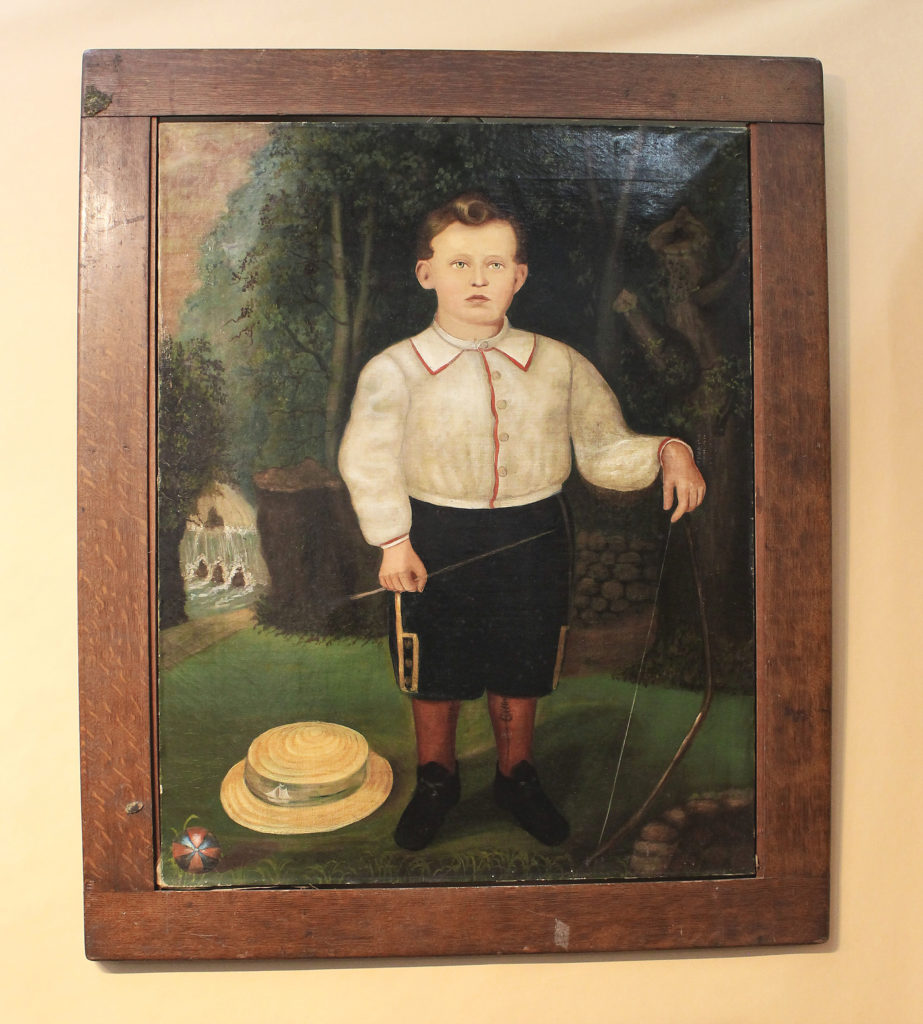
Found in an upstate New York collection where it had resided for about 50 years, Peter Bazar of Saratoga Fine Art, Saratoga Springs, N.Y., was still trying to attribute this portrait and asked $7,500.
One of the show’s most evocative pieces of textile art was in the booth of Newsom & Berdan Antiques, Hallowell, Maine, and Thomasville, Penn; an oversized Nineteenth Century silhouette became more complex the longer it was examined. Worked in dark brown wool, the silhouette showed the profile of an African American girl with a pleated blue cotton cap, mounted on paper. “It was found in Delaware, but it has Mississippi history,” explained Michael Newsom. The silhouette is dated from the last half of the Nineteenth Century, but not much else is known about the unusual portrayal. Newsom was asking $6,500.
One standout piece of furniture was made for sitting down, and that’s one of the few things known for certain about it. Placed beside a hearth arrangement in the booth of Joan Staufer, Catskill, N.Y., was a stool that exemplified the concept of “primitive.” Made from seven pieces of wood, Staufer estimated that it was Seventeenth Century and still incredibly sturdy. “I thought it was a hearth chair,” she said. “And then I thought it could have been used for weaving, but then someone suggested that it might have been for watching cockfights!” We hope not. Staufer continued that the stool may have been continental but was possibly Welsh, and asked $750 for it.
The York Fairgrounds and Convention Center is at 334 Carlisle Avenue. The next York Antiques Show and Sale will be on Friday and Saturday, September 22-23. For information, www.theoriginalyorkantiqueshow.com.












































